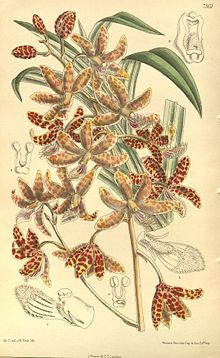Dipodium pictum
| Dipodium pictum | |
|---|---|

| |
| Illustration from Curtis's Botanical Magazine in 1904 | |
| Scientific classification | |
| Kingdom: | Plantae |
| Clade: | Tracheophytes |
| Clade: | Angiosperms |
| Clade: | Monocots |
| Order: | Asparagales |
| Family: | Orchidaceae |
| Subfamily: | Epidendroideae |
| Genus: | Dipodium |
| Species: | D. pictum
|
| Binomial name | |
| Dipodium pictum | |
Dipodium pictum, commonly known as brittle climbing-orchid or climbing hyacinth-orchid,[4] is an orchid species that is native to Malesia (including Indonesia and New Guinea) and the Cape York Peninsula in Australia.[5]
Description[edit]
Dipodium pictum is a slender vine with leaves that are arranged in a single plane These have overlapping bases and are about 30 to 40 cm long and 2 to 3 cm wide. The flowers are about 5 cm in diameter and have maroon spots.[5]
Taxonomy[edit]
The species was formally described in 1849 in The Journal of the Horticultural Society of London by English botanist John Lindley who gave it the name Wailesia picta.[6] It was transferred to the genus Dipodium by German botanist Heinrich Gustav Reichenbach in 1862.[2]
Dipodium pandanum, a species formally described by Frederick Manson Bailey in 1902, is treated as a synonym of Dipodium pictum in the Australian Plant Census.[3] However, Plants of the World Online accepts it as a species.[7] The type specimen for Dipodum pandanum was collected near Samarai in Papua New Guinea.[5]
Distribution[edit]
In Australia it is found within or on the edge of rainforest, often near watercourses, at altitudes ranging from 200 to 400 metres. Only four specimens have been recorded in Australia; from Kutini-Payamu National Park and a timber reserve in the McIlwraith Range on the Cape York Peninsula.[4]
Conservation[edit]
In Australia, the species is listed as "endangered" under the Commonwealth Environment Protection and Biodiversity Conservation Act as well as Queensland's Nature Conservation Act.[8]
References[edit]
- ^ "Dipodium pictum (Lindl.) Rchb.f." The Plant List version 1.1. Retrieved 29 January 2014.
- ^ a b "Dipodium pictum (Lindl.) Rchb.f., Xenia Orchid. 2: 15 (1862)". World Checklist of Selected Plant Families. Retrieved 29 January 2014.
- ^ a b "Dipodium pandanum F.M.Bailey". Australian Plant Name Index (APNI), IBIS database. Centre for Plant Biodiversity Research, Australian Government. Retrieved 31 January 2014.
- ^ a b "Approved Conservation Advice for Dipodium pictum" (PDF). Threatened Species Scientific Committee. 2008. Retrieved 31 January 2014.
- ^ a b c F.A.Zich; B.P.M.Hyland; T.Whiffen; R.A.Kerrigan (2020). "Dipodium pictum". Australian Tropical Rainforest Plants Edition 8 (RFK8). Centre for Australian National Biodiversity Research (CANBR), Australian Government. Retrieved 19 June 2021.
- ^ "Wailesia picta Lindl". Australian Plant Name Index (APNI), IBIS database. Centre for Plant Biodiversity Research, Australian Government. Retrieved 31 January 2014.
- ^ Dipodium pandanum F.M.Bailey. Plants of the World Online. Retrieved 12 January 2024.
- ^ "Dipodium pictum". SPRAT Profile. Department of the Environment (Australia). Retrieved 31 January 2014.
External links[edit]
 Media related to Dipodium pictum at Wikimedia Commons
Media related to Dipodium pictum at Wikimedia Commons Data related to Dipodium pictum at Wikispecies
Data related to Dipodium pictum at Wikispecies

